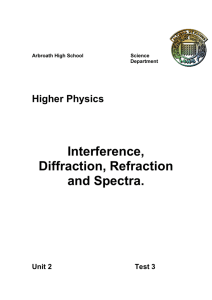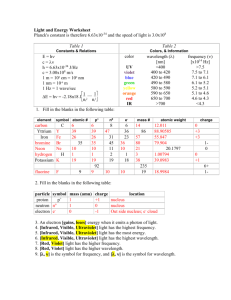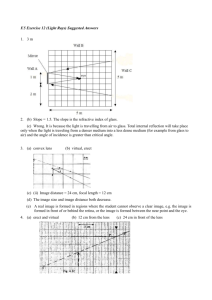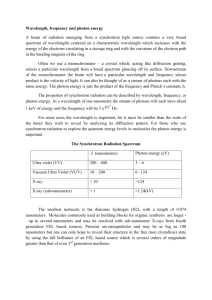Unit 10 PSA Key
advertisement
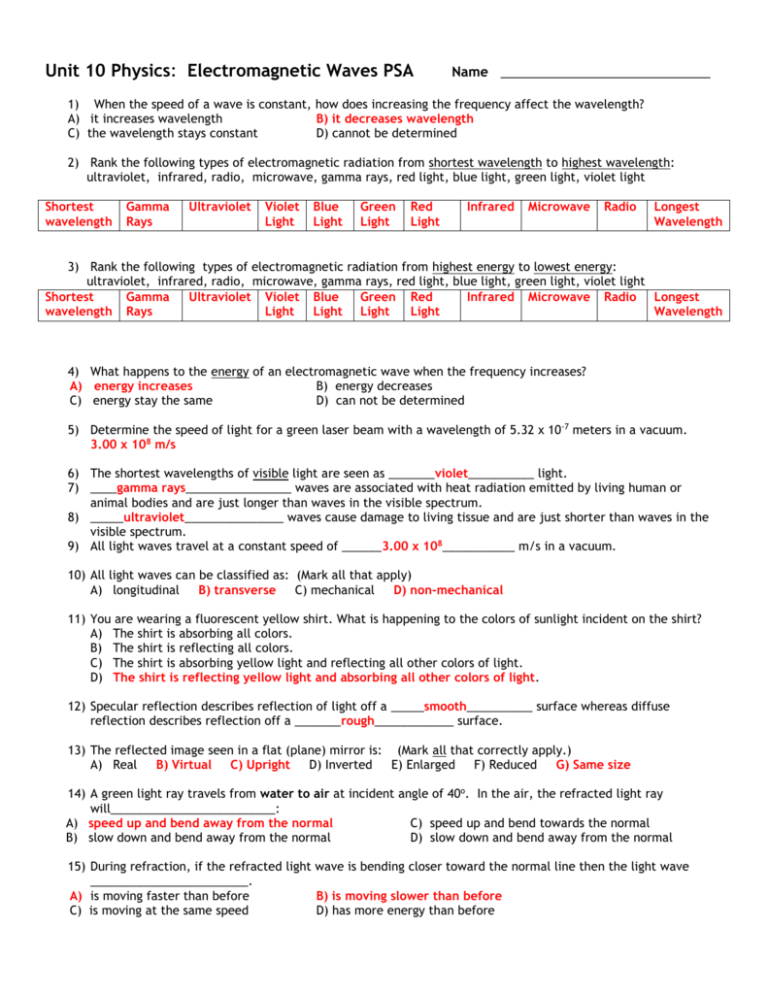
Unit 10 Physics: Electromagnetic Waves PSA Name _____________________________ 1) When the speed of a wave is constant, how does increasing the frequency affect the wavelength? A) it increases wavelength B) it decreases wavelength C) the wavelength stays constant D) cannot be determined 2) Rank the following types of electromagnetic radiation from shortest wavelength to highest wavelength: ultraviolet, infrared, radio, microwave, gamma rays, red light, blue light, green light, violet light Shortest wavelength Gamma Rays Ultraviolet Violet Light Blue Light Green Light Red Light Infrared Microwave Radio Longest Wavelength 3) Rank the following types of electromagnetic radiation from highest energy to lowest energy: ultraviolet, infrared, radio, microwave, gamma rays, red light, blue light, green light, violet light Shortest Gamma Ultraviolet Violet Blue Green Red Infrared Microwave Radio Longest wavelength Rays Light Light Light Light Wavelength 4) What happens to the energy of an electromagnetic wave when the frequency increases? A) energy increases B) energy decreases C) energy stay the same D) can not be determined 5) Determine the speed of light for a green laser beam with a wavelength of 5.32 x 10-7 meters in a vacuum. 3.00 x 108 m/s 6) The shortest wavelengths of visible light are seen as _______violet__________ light. 7) ____gamma rays________________ waves are associated with heat radiation emitted by living human or animal bodies and are just longer than waves in the visible spectrum. 8) _____ultraviolet_______________ waves cause damage to living tissue and are just shorter than waves in the visible spectrum. 9) All light waves travel at a constant speed of ______3.00 x 108___________ m/s in a vacuum. 10) All light waves can be classified as: (Mark all that apply) A) longitudinal B) transverse C) mechanical D) non-mechanical 11) You are wearing a fluorescent yellow shirt. What is happening to the colors of sunlight incident on the shirt? A) The shirt is absorbing all colors. B) The shirt is reflecting all colors. C) The shirt is absorbing yellow light and reflecting all other colors of light. D) The shirt is reflecting yellow light and absorbing all other colors of light. 12) Specular reflection describes reflection of light off a _____smooth__________ surface whereas diffuse reflection describes reflection off a _______rough____________ surface. 13) The reflected image seen in a flat (plane) mirror is: (Mark all that correctly apply.) A) Real B) Virtual C) Upright D) Inverted E) Enlarged F) Reduced G) Same size 14) A green light ray travels from water to air at incident angle of 40o. In the air, the refracted light ray will_________________________: A) speed up and bend away from the normal C) speed up and bend towards the normal B) slow down and bend away from the normal D) slow down and bend away from the normal 15) During refraction, if the refracted light wave is bending closer toward the normal line then the light wave ________________________. A) is moving faster than before B) is moving slower than before C) is moving at the same speed D) has more energy than before 16) If an incident light ray is going from a more dense medium into a less dense medium at an angle of 42° (to the normal), then the refracted light ray might be: A) 42° B) 39° C) 45° D) 21° E) 0° further from normal is faster 17) An incident light ray (the arrow) is being refracted from more optically dense medium to a less optically dense medium. On the picture to the right, draw a normal line and draw an approximate refracted ray. Does the refracted ray bend further or closer to the normal Less Optically Dense than the incident ray. __bends further from normal_______ More Optically Dense When compared to the incident light ray, is the refracted light ray moving faster or slower than the incidence ray? ___It moves faster____________________ 18) The type of image produced by a convex lens depends on: A) The size of the object B) the diameter of the lens C) which side of the lens the object is D) which side of the axis the object is (that is, oriented up or down) E) the position of the object with respect to the center of the lens and its focal point 19) A 1.5 cm tall object is placed 6.0 cm in front of a convex lens having a focal length of 4.0 cm. Draw a ray diagram to locate the image. Draw the lens in the middle first. Then label all the f and 2f points. Your drawing MUST be to scale and use a ruler. Describe the type of image formed: real or virtual upright or inverted enlarged, same size, or reduced Convex Lens 8cm 2F 4cm obj F 4cm 8cm F 2F image 20) Using the focal length equation, calculate the focal length when the distance to image is 10.0 cm and the distance to the object is 20.0 cm. (GUESS METHOD HELPS HERE!!!!!) Diagram: (Given + Unknowns) f = ???? cm di = 10 cm do = 20 cm Equation: 1 = 1 + 1 di do Substitute: : 1 = 1 + 1 f di do f 1 f = 1 + 10 1 20 1 f = 0.1 + 0.05 1 = 0.15 f (DO A SWITCHAROO) 1 = f 0.15 Solve: f = 6.67 cm 21) Which one of the following statements about lens images is true? A) Real images are always inverted, while virtual images are always upright B) Real images are always upright, while virtual images are always inverted. C) Real and virtual images are always upright. D) Real and virtual images are always inverted. 22) Name 5 wave interactions that support light acting like a wave. Reflection, refraction, diffraction, polarization, interference 23) Name 3 pieces of evidence that support light acting as a particle of energy (called a photon). ***** photoelectric effect, emission spectra, ********* and blackbody radiation 24) When the frequency of a photon increases, what happens to the energy of the photon? A) Photon energy increases B) Photon energy decreases. C) Enough energy exists to transform it into an electron D) Photon energy remains constant. 25) What occurs when an electromagnetic wave of frequency = 2.5 x 1015 Hz hits a sample of lead (Pb) with a threshold frequency = 1.03 x 1015 Hz? A) Electrons are ejected instantaneously. B) Electrons are absorbed instantaneously. C) Electrons become polarized. D) Actually nothing happens.





